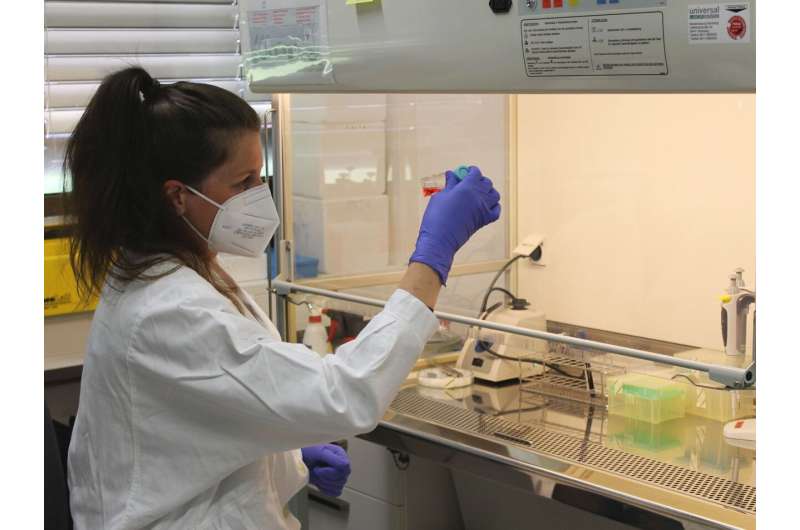Anja Ramsperger M.Sc., University of Bayreuth, is investigating whether microplastic particles can overcome biological barriers in a cell culture model. Credit: UBT / Chr. Wißler
The distribution of microplastics and nanoplastics in the environment, the potential of human exposure and particle uptake, and the absorption of these particles into tissues are topics that are being intensively researched worldwide.
An international research group of the EU project PlasticsFatE under the leadership of Prof. Dr. Christian Laforsch at the University of Bayreuth has evaluated international research literature on these issues. The results presented in the journal NanoImpact show that, concerning the risks for humans, the evidence is less certain than the broad spectrum of publications might suggest.
The project "Plastics Fate and Effects in the human body—PlasticsFatE," launched in April 2021, is among the first European research projects to systematically address the fate and effects of micro- and nanoplastics in the human body. These particles can be a few millimeters to a ten-thousandth of a millimeter in size.
A total of 27 universities, institutes and organizations from ten EU countries are involved in the project. Researchers from 11 member institutions in Germany, Italy, the Netherlands, Norway, Austria and Spain have joined forces for the study now published.
"First of all, we concentrated on the exposure pathways of humans to micro- and nanoplastics and the quantities at which the particles can enter humans. Furthermore, we reviewed the current literature on which natural defense mechanisms the particles would have to overcome to enter human tissues. Finally, we reviewed the studies reporting microplastic contamination of human tissues, which may pose a potential risk to human health.
"In evaluating the relevant publications, we paid particular attention to the scientific procedures that led to the published findings. Here, the description of the measures taken to avoid or monitor contamination during sample processing was often inadequately reported or left out altogether. Therefore, the reported results should be read and interpreted critically," says first author and Bayreuth doctoral student Anja Ramsperger (M.Sc.).
"Regarding the fate and resulting potential hazards of micro- and nanoplastics in humans, our study shows a differentiated picture. Which conclusions can be drawn from published results on the contamination of human tissues is often less clear than it seems at first glance when taking a closer look at the methods reported.
"I agree with the recent report by the World Health Organization that the currently available data are still insufficient to perform a profound risk assessment of micro- and nanoplastics to human health," says Prof. Dr. Christian Laforsch, coordinator of the study and spokesperson of the DFG Collaborative Research Centre 1357 "Microplastics" at the University of Bayreuth.
Most scientific work on the movement of micro- and nanoplastics focuses on the size and shape of the particles. However, other properties, such as physico-chemical properties, can strongly influence the particles' effects. Many studies work with industrially manufactured particles, mainly polystyrene spheres. But the particles occurring in the environment have a huge variety of properties. There is a broad consensus in research that the smaller the particles, the more often they interact with human tissue and individual cells. Biological barriers play a decisive role here: they prevent larger particles from penetrating tissues.
However, the authors of the new study point out an inconsistency. In some human tissue samples, the described particle exceeds the particle sizes for potential tissue translocation. One plausible explanation would be the contamination of the samples during sample processing. In addition, the research literature reviewed contains numerous indications that measures for quality assurance and quality control of samples have been insufficiently implemented and described.
In its study, however, the "PlasticsFatE" team also summarizes several fundamental findings about which there is no longer any doubt today: In most regions of the world, people's everyday lives contain increasing amounts of micro- and nanoplastics. The particles can enter the body through drinking water, food, inhaled air and cosmetics. Micro- and nanoplastic particles are taken up by humans mainly through the respiratory and gastrointestinal tract.
"Both at the European level and in the recently extended SFB 1357 'Microplastics' at the University of Bayreuth, we will intensively investigate the interactions between microplastics and organisms in the upcoming years. We aim to obtain reliable hazard assessments from which effective risk reduction measures can be derived. In doing so, however, we have to reckon with the fact that there may be long-term consequences of environmental contamination by plastics which are only rudimentarily recognizable today," says Laforsch.
More information: Anja F.R.M. Ramsperger et al, Nano- and microplastics: a comprehensive review on their exposure routes, translocation, and fate in humans, NanoImpact (2022). DOI: 10.1016/j.impact.2022.100441
Provided by Bayreuth University
























